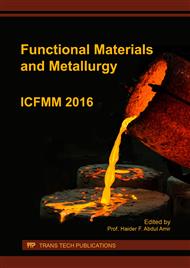[1]
J. Matějíček, H. Boldyryeva, V. Brožek, E, Čižmárová and Z. Pala. Tungsten-steel composites and FGMs produced by hot pressing, 21st International Conference on Metallurgy and Materials METAL (2012).
DOI: 10.1016/j.fusengdes.2015.06.154
Google Scholar
[2]
J. Matějíček, B. Nevrlá, M. Vilémová and H. Boldyryeva, Overview of processing technologies for tungsten-steel composites and FGMs for fusion applications, Nukleonika, Vol. 60 (2015), pp.267-273.
DOI: 10.1515/nuka-2015-0049
Google Scholar
[3]
M. Rieth, J.L. Boutard, S.L. Dudarev et al, Review on the EFDA programme on tungsten materials technology and science, Journal of Nuclear Materials, Vol. 417, (2011), pp.463-467.
Google Scholar
[4]
Y.Z. Ma, Q.S. Cai, W.S. Liu, S.H. Liu, Microstructure and mechanical properties of brazed tungsten/steel joint for divertor applications, Materials Science Forum, Vol. 789, (2014), pp.384-390.
DOI: 10.4028/www.scientific.net/msf.789.384
Google Scholar
[5]
Z.X. Wang, Y.Z. Ma, W.S. Liu, S.H. Liu, Q.S. Cai, Investigation of tungsten/steel brazing using nb interlayer, Materials Science Forum, Vol. 817, (2015), pp.27-34.
DOI: 10.4028/www.scientific.net/msf.817.27
Google Scholar
[6]
S. Topal, M. Gulgec, Thermal stress analysis of an FGM cylinder under the effect of convection and radially varying temperature distribution, Materials Science Forum, Vols. 631-632, (2010), pp.23-28.
DOI: 10.4028/www.scientific.net/msf.631-632.23
Google Scholar
[7]
A. Ozturk and M. Gulgec, Elastic–plastic stress analysis in a long functionally graded solid cylinder with fixed ends subjected to uniform heat generation, International Journal of Engineering Science, Vol. 49, (2011), pp.1047-1061.
DOI: 10.1016/j.ijengsci.2011.06.001
Google Scholar
[8]
A. Ozturk, M. Gulgec, Analytical solution of thermal stresses in a functionally graded solid cylinder within parabolic continuous grading, Applied Mechanics and Materials, Vol. 307, (2013), pp.364-367.
DOI: 10.4028/www.scientific.net/amm.307.364
Google Scholar
[9]
M.M. Gasik, Micromechanical modeling of functionally graded materials, Computational Materials Science, Vol. 13, (1998), pp.42-55.
DOI: 10.1016/s0927-0256(98)00044-5
Google Scholar
[10]
A.M. Howatson, P.G. Lund and J.D. Todd, Engineering Tables and Data, (1972), p.41.
Google Scholar
[11]
J.M. Missiaen, J.J. Raharijaona, A. Antoni, C. Pascal, M. Richou, P. Magaud, Design of a W/steel functionally graded material for plasma facing components of DEMO, Journal of Nuclear Materials, Vol. 416, (2011), pp.262-269.
DOI: 10.1016/j.jnucmat.2011.05.054
Google Scholar
[12]
P. Fernandez, A.M. Lancha, J. Lapena, M. Serrano, and M. Hernandez-Mayoral, Reduced Activation Ferritic/Martensitic Steel Eurofer 97 as Possible Structural Material for Fusion Devices. Metallurgical Characterization on As-Received Condition and after Simulated Services Conditions (No. CIEMAT-1048), Centro de Investigaciones Energeticas, (2004).
DOI: 10.1016/s0920-3796(01)00563-4
Google Scholar
[13]
R.C. Hibbeler, Mechanics of Materials, 5th ed., Prentice Hall, New Jersey, (2003).
Google Scholar
[14]
C.T. Wang, Applied Elasticity, McGraw-Hill Book Company, New York, (1953), p.73.
Google Scholar


